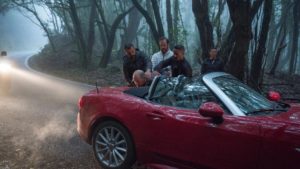
Opera Meets Film: How ‘Les Contes d’Hoffmann’s’ Barcarolle Explores ‘The Whistlers’ Tragic Arc
By David Salazar“Opera Meets Film” is a feature dedicated to exploring the way that opera has been employed in cinema. We will select a section or a film in its entirety, highlighting the impact that utilizing the operatic form or sections from an opera can alter our perception of a film that we are viewing. This week’s installment features “The Whistlers.”
Music is everywhere in Corneliu Porumboiu’s “The Whistlers.” The mafia at the core of the story communicates via whistling. The film ends during a music light show at the Gardens by the Bay in Singapore. There is a motel called Motel Opera where many of the film’s major sequences unravel and where opera becomes a major part of the soundtrack.
As the protagonist, Cristi arrives at the hotel with the intent of meeting with Zsolt, a criminal that the police is building a case against, the film introduces the hotel’s sign with Bellini’s “Casta Diva” slowly taking over the soundtrack (Anna Netrebko is the singer). To this point, music has been scarce, so the introduction of the aria shifts the environment and mood of what has been a rather claustrophobic and complicated thread of plots.
Cristi enters the hotel to reveal that the piece is in fact playing in the hotel. Moments later, he will ask about the music, to which the clerk at the hotel will respond that he wants to “educate” people. The key here is that the audience is the group that he is hoping to educate with opera becoming a major motif from here on out. Moreover, it is at this point and in this location where a lot of the clues of the stories development emerge. Those who aren’t “educating” themselves (paying attention) will fail to follow when all is said and done.
“Casta Diva” provides a unique starting point as it is a sublime piece of music that strives the ideal in both its structure and emotion. In the context of the strange hotel and the tensions of the story, the emotional dissonance of the piece only adds another layer of confusion for the viewer; during a New York Film Festival screening of the film, this particular section generated some of the biggest laughs, once again establishing the emotional confusion around the sequence.
Porumboiu jumps to Barbarina’s “L’ho perduto” from “Le Nozze di Figaro,” an aria in a minor key that has echoes of darkness and loneliness; it presents another emotional jolt for the viewer.
But then Porumboiu manages his masterstroke of operatic inclusion by placing the Barcarolle from “Les Contes d’Hoffmann.” It is an iconic duet that people identify in pop culture and would easily identify in the film immediately. Its own repetitive melodic development dovetails nicely with a film full of double, triple, and quadruple crossings, the constant reversals of the plot feeling cyclical. When you throw in the context of the passage, which presages the darkest betrayals of the opera, the piece fits in perfectly. Porumboiu returns to the piece on three separate occasions and taken together, they build up to a massive thematic development that furthers the Hoffmann connection.
In the opera, the Barcarolle opens the Giulietta act where she will ask Hoffmann to give up his shadow (his soul). It is the titular character’s emotional lowpoint, which is furthered by the fact that he commits a murder in this sequence as well.
In “The Whistlers,” the Barcarolle signals Cristi’s failure and his increasing loss in the turmoil of the mess he has gotten himself in. In the hotel, he receives a package of money from Zsolt. With the Barcarolle playing in the soundtrack, he takes the money and runs to his mother’s house and hides it in a cellar. Later in the story, her mother will donate the money to the church, which will then make its way to the police, making Cristi a suspect colluding with the mob.
The piece returns a few scenes later when Cristi gets in the car with Gilda. She decides to play some music, which is naturally the Barcarolle. She claims that it is Zsolt’s car and that he enjoys the opera. It immediately connects the audience with the scene in the hotel where Zsolt hands the money to Cristi. But here, Cristi concocts a plan to steal the car and run away from the mob. Again, the music dominates the soundtrack as he snatches the keys from Gilda, gets in the car, and drives away. But once again, he gets caught, beaten, and abducted by the mobsters.
It returns one last time at the climax of the story where all the action returns to the hotel. Gilda heads to the hotel to await Zsolt and Cristi so they can run away with the money. But another cop tails her. He gets dispatched by the clerk (who is Zsolt’s lover) and eventually he joins forces with Gilda (after attempting to kill her) to steal the money and run. Meanwhile Cristi escapes the movie studio where the police is arresting the mobsters and attempts to find his way to Gilda. However, another officer finds him on the stream and runs him over, the Barcarolle coming to a close.
Summed up, the three appearances will feature Cristi failing three different facets of his life. He fails his mother, who thinks that he has gone down the wrong path by getting into a nefarious business transaction; she gives the money to the church hoping that prayers will fix her broken son. Then he loses the trust of the mobsters, putting his life in danger. Finally, he gets run over by his own colleague, a police officer, finishing off his fall from grace. In some ways, this three-part failure mirrors Hoffmann’s three failed love affairs, cementing the Barcarolle’s connection in the film as both symbolic and intertextual.
Categories
Opera Meets Film


